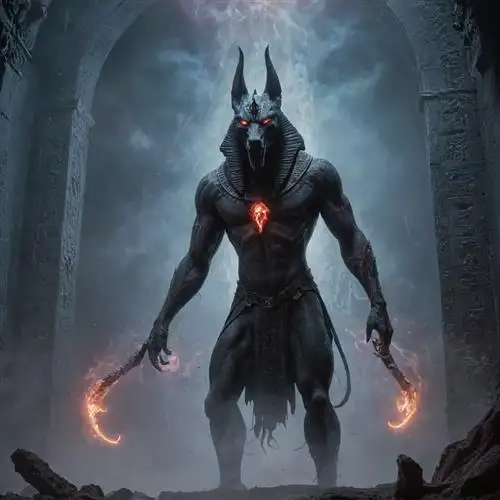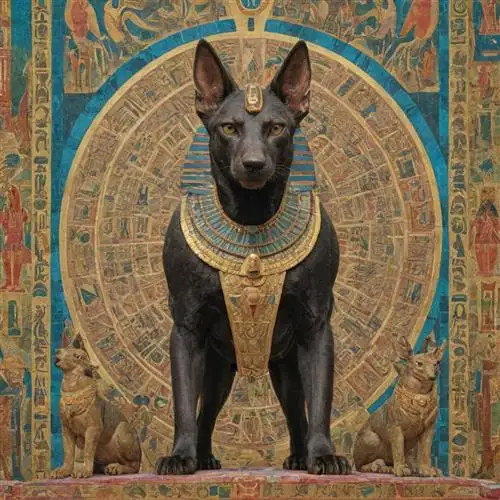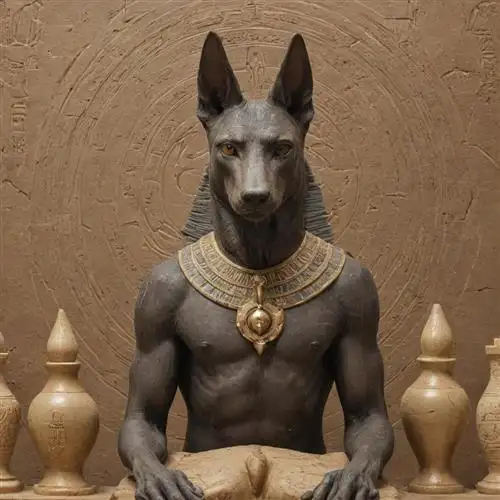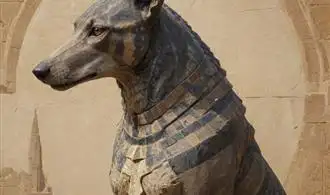
Anubis The Guardian of the Underworld
Anubis, the jackal-headed god of ancient Egyptian mythology, was revered as the guardian of the underworld and the protector of the dead. As one of the most prominent deities in the Egyptian pantheon, Anubis played a crucial role in the afterlife rituals and funerary practices of the ancient Egyptians.
At the heart of Anubis' iconography lies his primary function as the gatekeeper of the underworld, responsible for guiding the deceased through the treacherous journey to the afterlife. As the god of embalming and mummification, Anubis oversaw the crucial process of preserving the body, ensuring the soul's safe passage to the realm of the dead.
The jackal-like features of Anubis were not mere aesthetics; they held deep symbolic meaning. The jackal was revered in ancient Egypt for its keen senses and ability to navigate the liminal spaces between the world of the living and the dead. Anubis, with his canine head, was thus seen as the perfect intermediary, capable of bridging the gap between the physical and the spiritual realms.
In the Egyptian afterlife, Anubis was responsible for weighing the heart of the deceased against the feather of truth, a critical step in determining the worthiness of the individual's soul. This ritual, known as the "Weighing of the Heart," was a pivotal moment in the journey to the afterlife, and Anubis' role as the overseer of this process cemented his status as the guardian of the underworld.
The iconography of Anubis extends beyond his physical representation. He was often depicted holding the crook and flail, symbols of royal authority, signifying his importance in the Egyptian pantheon. Additionally, Anubis was associated with the color black, which was symbolic of the fertile soil of the Nile River and the mummification process.
The veneration of Anubis was not limited to the royal elite; his influence permeated all levels of ancient Egyptian society. Ordinary Egyptians sought the protection and guidance of Anubis, believing that his presence in the afterlife would ensure a safe and successful journey to the realm of the dead.
The Iconographic Evolution of Anubis
Anubis, the jackal-headed Egyptian deity, has captivated the imagination of scholars and enthusiasts alike for centuries. His iconographic representation has undergone a fascinating transformation throughout the ages, reflecting the evolving beliefs and cultural influences of ancient Egypt. Delving into the intricacies of Anubis' visual symbolism offers a glimpse into the complex tapestry of ancient Egyptian mythology and the enduring significance of this enigmatic figure.
One of the earliest known depictions of Anubis dates back to the Predynastic period, where he was often portrayed as a jackal or a hybrid being with a jackal head and human body. This animal-centric representation was likely rooted in the jackal's association with the desert and its role as a scavenger, which was believed to have significance in the afterlife rituals and funerary practices of the time.
As Egyptian civilization progressed, the iconography of Anubis underwent a more pronounced anthropomorphic shift. During the Old Kingdom, Anubis was often depicted with a fully human body and a jackal head, solidifying his status as a distinct divine entity. This visual transformation reflected the growing complexity of Egyptian theology, where Anubis assumed a more prominent role in the pantheon as the guardian of the dead and the patron of mummification.
The Ptolemaic and Roman periods witnessed further refinements in the visual representation of Anubis. During this time, Anubis was occasionally portrayed with a more naturalistic jackal head, blending the animal and human elements in a manner that emphasized his dual nature as both a divine and a chthonic figure. Additionally, Anubis was sometimes depicted holding various funerary symbols, such as the crook and flail, further reinforcing his association with the afterlife and the rituals surrounding death and burial.
Anubis in the Afterlife Rituals
Anubis, the jackal-headed deity, held a profound significance in the ancient Egyptian afterlife rituals. As the god of embalming and the protector of the dead, Anubis played a crucial role in the intricate process of mummification and the journey of the deceased into the afterlife.
At the heart of Anubis's involvement in the afterlife rituals was his responsibility for the preservation and protection of the body. The mummification process, which ensured the preservation of the physical form, was overseen by Anubis. He was believed to have taught the art of embalming to the earliest Egyptian embalmers, ensuring the proper preparation of the deceased for their eternal existence.
Beyond the mummification process, Anubis also played a vital role in the final judgment of the deceased. In the renowned "weighing of the heart" ceremony, Anubis was responsible for guiding the deceased's soul to the underworld and overseeing the weighing of the heart against the feather of Ma'at, the goddess of truth and justice. This pivotal moment determined whether the individual would be granted eternal life in the afterlife or condemned to oblivion.
Anubis's presence was not limited to the judgment ceremony; he was also believed to accompany the deceased on their journey to the underworld. As the guardian of the necropolis, Anubis ensured the safe passage of the dead through the perilous underworld, protecting them from any potentially harmful entities or obstacles.
The iconography surrounding Anubis in the afterlife rituals was rich and multilayered. He was often depicted as a jackal-headed figure, symbolizing his connection to the wild canines that roamed the desert regions near the necropolis. Additionally, Anubis was sometimes represented as a fully jackal-like figure, emphasizing his role as a psychopomp, a guide of souls to the afterlife.
In certain funerary rites, Anubis was depicted as standing guard over the mummy, ensuring the preservation and protection of the physical body. This visual representation underscored his crucial role in the mummification process and the safeguarding of the deceased's remains.
The Symbolic Significance of Anubis
Anubis, the ancient Egyptian god of the dead, holds a profound and multifaceted symbolic significance that has captivated scholars and enthusiasts alike. As the guardian of the underworld and the protector of the deceased, Anubis embodies the intricate relationship between life, death, and the transition between the two. His iconography, deeply rooted in the cultural and religious fabric of ancient Egypt, offers a window into the complex beliefs and practices surrounding the afterlife.
One of the most striking aspects of Anubis' symbolic representation is his distinctive jackal-headed form. The jackal, a creature known for its scavenging behavior and association with the desert, was believed to have a deep connection with the realm of the dead. Anubis, as the jackal-headed deity, was seen as the master of this liminal space, guiding the deceased through the treacherous journey to the afterlife.
The color black, which is commonly associated with Anubis, holds profound symbolic significance as well. Black was believed to represent the fertile soil of the Nile River, which was the source of life and regeneration in ancient Egypt. Additionally, black was linked to the color of the mummified body, symbolizing the transformation and preservation of the physical form in preparation for the afterlife.
Anubis' role as the god of embalming and mummification further emphasizes his importance in the funerary rites and practices of ancient Egypt. As the overseer of the mummification process, Anubis ensured the proper preservation of the deceased, enabling the soul to transition to the afterlife successfully. This critical function solidified Anubis' position as a central figure in the complex Egyptian beliefs surrounding death and the afterlife.
Moreover, Anubis' association with the scales of judgment, where the heart of the deceased was weighed against the feather of Ma'at (the goddess of truth and justice), underscores his role as a guardian of the moral and ethical standards of the afterlife. This ritual, known as the "Weighing of the Heart," was a crucial step in the journey of the soul, and Anubis' presence as the overseer of this process further reinforced his importance in the Egyptian cosmology.
Anubis in Contemporary Interpretations
Anubis, the enigmatic jackal-headed deity, has long been a subject of fascination for those delving into the rich tapestry of ancient Egyptian iconography. In the contemporary landscape, this iconic figure continues to captivate and inspire, as artists, scholars, and enthusiasts explore new dimensions of his enduring legacy. Delving into the realm of Anubis in contemporary interpretations unveils a wealth of insights that shed light on the enduring relevance of this ancient Egyptian icon.
One of the most striking aspects of Anubis in contemporary art and design is the diverse range of mediums and styles through which he is reimagined. From striking digital illustrations that capture the otherworldly essence of the jackal-headed god, to intricate tattoo designs that adorn the human canvas, the visual representations of Anubis have evolved to reflect the sensibilities of the modern age. These contemporary interpretations often blend traditional Egyptian motifs with modern aesthetics, creating a captivating fusion that resonates with a global audience.
Another fascinating aspect of Anubis in contemporary interpretations is the way in which his symbolism is reinterpreted and applied to address contemporary concerns. For instance, some artists have utilized the imagery of Anubis to explore themes of death, transformation, and the afterlife, often imbuing their work with a sense of mysticism and reverence for the ancient Egyptian belief systems. By drawing parallels between the ancient and the modern, these interpretations invite viewers to ponder the enduring relevance of Anubis in our ever-evolving world.
Interestingly, the figure of Anubis has also found a place in the realm of popular culture, appearing in various forms of media, from comic books and video games to literature and film. These depictions often take creative liberties, reimagining Anubis within the context of fantastical narratives or blending his iconography with other mythological elements. While these interpretations may depart from the historical and cultural nuances of the original deity, they nonetheless contribute to the ongoing dialogue surrounding Anubis and his enduring appeal.
One particularly noteworthy example of Anubis in contemporary interpretations is the article "I Mastered Anubis Iconography and So Can You," which delves into the intricate details of the jackal-headed god's visual symbolism and provides valuable insights for those seeking to deepen their understanding of this captivating figure. By exploring the ways in which artists and enthusiasts have embraced and reinterpreted Anubis, this article offers a comprehensive perspective on the enduring influence of this ancient Egyptian icon in the contemporary landscape.















